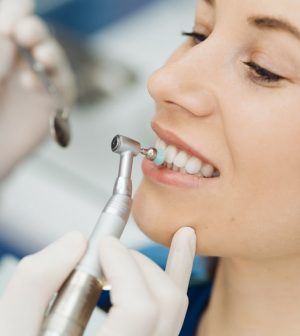- Navigating Your Midlife Crisis: Embracing New Possibilities
- City Raccoons Showing Signs of Domestication
- Mapping the Exposome: Science Broadens Focus to Environmental Disease Triggers
- One Week Less on Social Media Linked to Better Mental Health
- Your Brain Changes in Stages as You Age, Study Finds
- Some Suicide Victims Show No Typical Warning Signs, Study Finds
- ByHeart Formula Faces Lawsuits After Babies Sickened With Botulism
- Switch to Vegan Diet Could Cut Your Greenhouse Gas Emissions in Half
- Regular Bedtime Does Wonders for Blood Pressure
- Dining Alone Could Mean Worse Nutrition for Seniors
Dental Veneers: Everything You Need to Know

Looking for a brand new smile?
Many people with chipped, worn or indelibly stained teeth may ponder the possibility of veneers. They’re wholly cosmetic, typically aren’t covered by dental insurance and can cost thousands of dollars, so it’s best to understand veneers well before you embark on getting them.
Experts at the Cleveland Clinic define a veneer as a covering “over the front surfaces of your teeth.” They’re typically made of a tooth-colored composite material or porcelain, and they are meant to be permanent.
Veneers are different than crowns, because a crown covers the whole of the tooth area. Part of a crown’s purpose is to repair a damaged tooth, giving it strength and protection. Veneers are only cosmetic.
Who needs veneers?
According to the experts, veneers are for anyone who wants a more beautiful smile. They can help hide chipped or broken teeth, gaps in tooth spacing, stains that can’t be removed, small or misshapen teeth and other imperfections.
Folks with extensive cavities or gum disease may not be good candidates for veneers, the Cleveland Clinic experts said. Health issues like those may need to be rectified before a dentists considers veneers.
What are the different types of veneers?
There are three main types: porcelain, composite and no-prep veneers.
Porcelain veneers
Porcelain restorative veneers are typically custom-made to address individual imperfections. A certain amount of the tooth’s original enamel must first be removed, to produce a “roughening” that allows the veneers to take hold.
Composite veneers
These veneers are used to hide “mild” cosmetic issues, the Clinic said. Composite is typically the same kind of tooth-colored compound a dentist would use for dental bonding.
No-prep veneers
These veneers are a less invasive option. They’re made to fit your individual smile, but may involve less enamel being removed from the original tooth. However, not everyone is a suitable candidate for no-prep veneers, so ask your dentist.
Removable (“pop on”) veneers
These veneers pop on and off the original teeth, much like retainers, and help hide imperfections. The downside: They can make eating tougher, and even impede speech.
Getting veneers: Before placement
During your first appointment, your dentist will examine your mouth to see if you’re a suitable candidate for veneers. If you are, the next step is for the dentist to remove a small bit of enamel, after which they take a small impression of your teeth.
Often it can take weeks for your new veneers to arrive at your dentist’s office from the lab.
Getting veneers: Placement
After double-checking your mouth for the shape, color and fit of your veneers, your dentist will bond the veneers into place using dental cement.
This is typically an outpatient procedure, with many patients going home the same day.
Post-placement care
The care of veneers is similar to that of your original teeth: Brushing, flossing and checking in regularly with your dentist, the Cleveland Clinic says. A brush with soft bristles and a non-abrasive toothpaste are preferred.
Along those lines, avoid crunchy foods like carrots, apples and tough meats, or only chew them using your back teeth.
Veneers can also be stained, so try to avoid substances like berries, red wine, coffee and tea, the Cleveland Clinic experts said.
SOURCE: Cleveland Clinic, news release, Jan. 19, 2024
Source: HealthDay
Copyright © 2025 HealthDay. All rights reserved.










